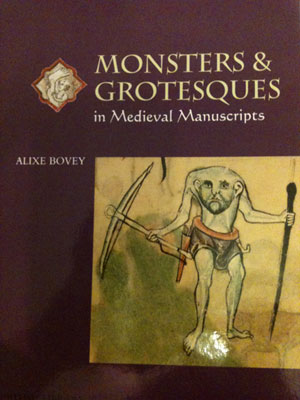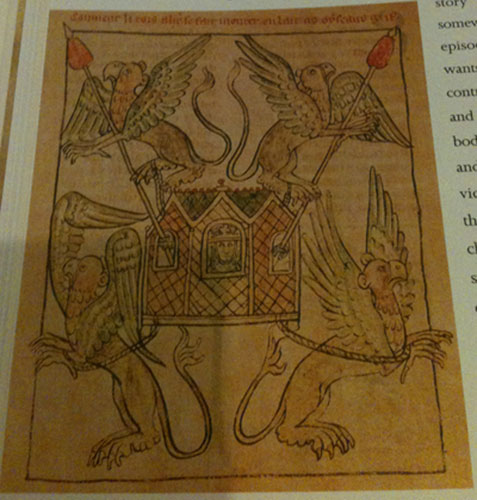 On Friday I spent several pleasant hours in my favorite bookshop. I found three books I had to have; one of them a slim paperback called Monsters and Grotesques in Medieval Manuscripts by Alixe Bovey. If you’ve ever looked at photos of old manuscripts you’ve probably noticed the weird creatures in the margins. Bovey’s book is only 59 pages long (and less than ten inches high), but it has lots of lovely colour photographs and offers a fascinating glimpse into why our Medieval ancestors wanted these fantastical creatures in the margins of their books (assuming I had Medieval ancestors who could read let alone afford a book).
On Friday I spent several pleasant hours in my favorite bookshop. I found three books I had to have; one of them a slim paperback called Monsters and Grotesques in Medieval Manuscripts by Alixe Bovey. If you’ve ever looked at photos of old manuscripts you’ve probably noticed the weird creatures in the margins. Bovey’s book is only 59 pages long (and less than ten inches high), but it has lots of lovely colour photographs and offers a fascinating glimpse into why our Medieval ancestors wanted these fantastical creatures in the margins of their books (assuming I had Medieval ancestors who could read let alone afford a book).
What I didn’t know was that a lot of these monsters were actually considered real. I just assumed they were the creations of drunken monks bored out of their minds after transcribing the same book for the umpteenth time. I didn’t know that most of these odd looking creatures were believed to be real monsters living in far away lands or that books describing these monsters went back to the Pliny the Elder (23-79 AD Rome). This is an amazing example of fiction passed down through centuries as factual information.
The whole concept of history has always fascinated me. At the end of the day evaluating history (even what happened yesterday) is like looking through a very large window made up of small squares of hand blown glass. What we see depends on which part of the window we’re looking through. Each square frames a different portion of the scene; each pane making things seem closer or farther depending on its thickness. We can all look at the same scene, but each of us will notice and value different aspects of what we see. Yet, if we’re taught a certain aspect of history from an early age we tend to grow up and believe it. If no one offers credible evidence to the contrary or we become emotionally attached to what we’re taught we can become blind to the rest of the window. What I find really fascinating about these Medieval monsters is that many of them still inhabit our cultural landscape. We may not believe that unicorns are real, but does anyone reading this not know what a unicorn is or what they look like even though they don’t exist (let’s not bring the one horned goat into the argument).
Quoting from Bovey’s book on page 8, “Stories of the Monstrous races written about by Ctesias, Pliny and Solinus were reshaped late in the tenth century in an Anglo-Saxon text known today as the Wonders of the East. Circulating in both Latin and Old English between c.970-c.1150, the Wonders described the marvellous creatures and races of humans that lived on distant continents. Among the phenomena described in the Wonders are dog-headed men called cynocephali; ants as big as dogs; giants; a land infested with 150-foot dragons;men with heads in their chests called blemmyae (illustrated on the cover);polyglot man-eaters called donestre; and griffins, with eagle heads, bovine tales and lion’s feet. Medieval people did not merely want to read about these monstrous races and beasts in ancient texts; they wanted to see pictures of them as well.” So illustrators obliged by concocting endless personal versions.
Strangely (or not so strangely) today when people discuss the possibility of people living on other planets they imagine them looking like the monsters in medieval manuscripts. How many Scientists (who’d even discuss the possibility of aliens) would suggest that aliens might look just like us? It seems preposterous. Why would they look like us? They’re far far away! As far away as the cultures Alexander conquered to the average person living in Medieval Europe. As Bovey points out, even those Medieval people who were widely traveled (we know Viking merchants were trading in distant lands long before Anglo Saxon rule fell) and yet finding foreigners had the same number of heads, legs, same size ears etc didn’t diminish the belief in these far away monsters. Is there something in the human psyche that needs a distant monster? What do distant monsters do for us? I’ll now have to go look up some of books on the further reading list and see if I can find out. This little book is a fascinating introduction to an aspect of cultural history that had completely escaped me. I highly recommend it. Whether you check it out from your local library or buy your own copy it offers a few more panes of glass through which to glimpse the past. I’m glad I bought it.
One of my favorite little pictures is of Alexander the Great flying through the skies…he’s holding spears stabbed through with raw meat to entice the griffins into the skies! I don’t know why, but I just love it. It’s so inventive. It makes me wonder if there was a point…why did he want to risk like and limb to fly into the skies? Did he want to see how long he could hold two heavy poles before his arms fell off or did he just want to experience flying through the air? See a tactical advantage to defeat an enemy? That makes me wonder…did people who lived before the invention of the balloon…did they ever have dreams where they flew? Now I’ll have to see if I can find the answer to that too. I should go before I ask myself any more questions and end up not having any time left to write romances.

